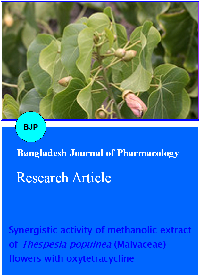Synergistic activity of methanolic extract of Thespesia populnea (malvaceae) flowers with oxytetracycline
DOI:
https://doi.org/10.3329/bjp.v4i1.958Keywords:
Methanolic extract, Oxytetracycline, Synergistic activity, Thespesia populneaAbstract
The object of this study was to formulate new, cost effective anti-microbial combination for multidrug resistant diseases based on the synergistic activity of oxytetracycline with methanolic extract of Thespesia populnea (Malvaceae) a medicinal plant common in South India. The MIC of methanolic extracts in combination with oxytetracycline using 12 different both gram positive and gram negative bacteria was found to be around (62.5 µg/mL to 1000 µg/mL). The synergistic activity was verified using Kirby and Bauer techniques. 83.3% shows synergistic activity against all 12 different bacteria both gram positive and gram negative species. The highest synergism rate was attained against Shigella boydii (ATCC8700).
Downloads
1224
670 Read
311
References
Betoni JEC, Mantouani RP, Barbosa LN, Stasi LCD, Fernander A. Synergism between plant extract and antimicrobial drugs used on Staphylococcus aureus diseases. Mem Inst Oswaldo Cruz, Rio De Janerio. 2006; 101: 387-90.
Black JG. Microbiology: Principles and application. New York, Prentice Hall, 1996, p 260.
Chang S, Yahg M, Wen H, Chem J. Estimation of total flavonoid component in propolis by two complementary colorimetric methods. J Food Drug Anal. 2002; 10: 178-82.
Evans WC. Treese and Evans pharmacognosy. London, Balliere, Tindall, 1996, p 388.
Ferreira MJU, Ascenso JR, Valdeira L, Duarte A, Frade JP, Freitas G. Evaluation of antiviral and antimicrobial activities of triterpenes isolated from Euphorbia segetalis. Nat Prod Res. 2003; 17: 375-80.
Gupta P, Murali P, Murali MV, Faridi MMA, Kaul PB, Ramachandran VC, Talwar V. Clinical profile of Klebsiella septicaemia in neonates. Indian J Paediatr. 1993; 60: 565-72.
Kumar AS, Mazumder, Saravanan VSA. Antihyperlipidemic activity of Camellia sinensis leaves in Triton-WR 1339 induced Albino rats. Phcog Mag. 2008; 4: 60-64.
Li S, Lo CY, Ho CT. Hydroxylated polymethoxy flavones and methylated flavonoids in sweet orange (Citrus sinensis) peel. J Agric Food Chem. 2006; 54: 4176-85.
Mastroeni P. Immunity to systemic salmonella infections. Curr Mol Med. 2002; 2: 393-406.
Nascimento GGF, Locatelli J, Freitas PC, Silva GL. Antibacterial activity of plant extracts and phytochemicals on antibiotic-resistant bacteria. Braz J Microbiol. 2000; 31: 247-56.
Nazaruk J, Jakoniuk P. Flavonoid composition and antimicrobial activity of Crisium rivulare (jacq) flowers. J Ethnopharmacol. 2005; 102: 208-12.
Shirwaikarkumar A, Krishnan AV, Sreenivasan KK. Chemical investigation and antihepatotoxic activity of Thespesia populnea. Int J Pharmacog. 1995; 33: 305-10.

Additional Files
Published
How to Cite
Issue
Section
License
Authors who publish with this journal agree to the following terms:
- Authors retain copyright and grant the journal right of first publication with the work simultaneously licensed under a Creative Commons Attribution License that allows others to share the work with an acknowledgement of the work's authorship and initial publication in this journal.
- Authors are able to enter into separate, additional contractual arrangements for the non-exclusive distribution of the journal's published version of the work (e.g., post it to an institutional repository or publish it in a book), with an acknowledgement of its initial publication in this journal.
- Authors are permitted and encouraged to post their work online (e.g., in institutional repositories or on their website) prior to and during the submission process, as it can lead to productive exchanges, as well as earlier and greater citation of published work (See The Effect of Open Access).
